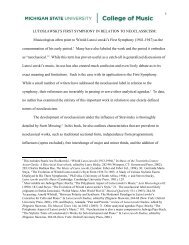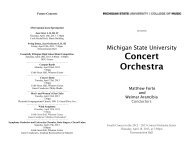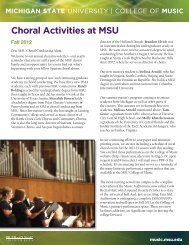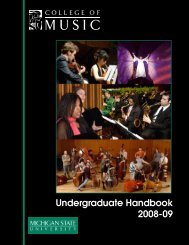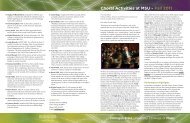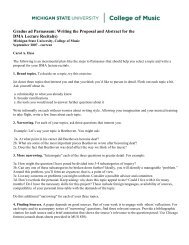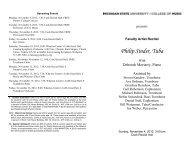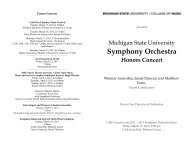Poetics, Theater and Art: The Legacy of Gabriel Garcia Marquez
Poetics, Theater and Art: The Legacy of Gabriel Garcia Marquez
Poetics, Theater and Art: The Legacy of Gabriel Garcia Marquez
- No tags were found...
You also want an ePaper? Increase the reach of your titles
YUMPU automatically turns print PDFs into web optimized ePapers that Google loves.
LATIN AMERICAN IMPRINTS<strong>Poetics</strong>, <strong><strong>The</strong>ater</strong> <strong>and</strong> <strong>Art</strong>: <strong>The</strong> <strong>Legacy</strong> <strong>of</strong> <strong>Gabriel</strong> <strong>Garcia</strong> <strong>Marquez</strong>Center for Latin American <strong>and</strong> Caribbean StudiesSPRING SYMPOSIUM APRIL 15 -19, 2013
<strong>The</strong> madness <strong>of</strong> abundanceLATIN AMERICAN IMPRINTS—POETICS, THEATER AND ART:THE LEGACY OF GABRIEL GARCIA MARQUEZSymposium OverviewOur recent symposia targeted issues <strong>of</strong> inequality, equity gaps, <strong>and</strong> development challenges tied to the humancondition. This agenda considered more indirectly than directly threads <strong>and</strong> themes <strong>of</strong> social justice. This year’ssymposium helps to better balance our portfolio with matters magically spun from perceived truth, <strong>and</strong> from love,death, politics <strong>and</strong> power by a master <strong>and</strong> Nobel laureate. In my own case, <strong>Gabriel</strong> García Márquez’ One HundredYears <strong>of</strong> Solitude first appeared in 1969 in Mejía, Arequipa, Perú, where Arequipeño summer beachgoers were mostlyreading favorite son Mario Vargas Llosa’s <strong>The</strong> Green House. Later, I would be struck by the universal optimism everafter ascribed onto the historied body that is Latin America, voiced by Juvenal Urbino in Love in the Time <strong>of</strong> Choleraas a perceived truth:“Como será de noble esta ciudad que tenemos 400 años de estar trat<strong>and</strong>o de acabarcon ella, y todavía no lo logramos.”“How noble this city must be for we have spent 400 years trying to finish it <strong>of</strong>f <strong>and</strong>still we have not succeeded.”<strong>The</strong> Center <strong>and</strong> the Department <strong>of</strong> Romance <strong>and</strong> Classical Studies welcome the support <strong>and</strong> collaboration <strong>of</strong>the MSU Office for Inclusion <strong>and</strong> Intercultural Initiatives, especially for the April 18 theatrical performanceculminating our new Hispanic <strong><strong>The</strong>ater</strong> (SPN 491) course. This performance is also the result <strong>of</strong> a key alliance withthe Department <strong>of</strong> <strong><strong>The</strong>ater</strong>. <strong>The</strong> 2013 symposium builds upon Don Juan Week, an important campus-wide creative1endeavor in fall 2012. This event brought Carlos Morton to MSU to speak on “Don Juan through the Ages”—in<strong>The</strong> Don Juan Traditions symposium—complemented by a staged reading <strong>of</strong> a Morton play, Johnny Tenorio, <strong>and</strong>selections from Don Giovanni by the MSU Opera <strong>The</strong>atre (College <strong>of</strong> Music).<strong>The</strong> 2013 symposium also aligns with another initiative funded by the Office for Inclusion <strong>and</strong> InterculturalInitiatives—the College <strong>of</strong> Music’s Latin is America initiative, a central signifier <strong>of</strong> the many ways that society writlarge has been enriched by Latin Americans. Importantly, the symposium kicks <strong>of</strong>f by putting students first with aposter session on “Latin America <strong>and</strong> Its Literature”. <strong>The</strong>n two plenary keynote addresses will discuss the legacy<strong>of</strong> García Márquez. <strong>Art</strong>istic expression is pursued in “Magical Realism on Canvas”, <strong>and</strong> is subsequently discussedwith the audience by the invited panel <strong>of</strong> presenters.Robert W. BlakeDirector for the Center for Latin American <strong>and</strong> Caribbean Studies1Pr<strong>of</strong>essor <strong>of</strong> Dramatic <strong>Art</strong>s at the University <strong>of</strong> California Santa Barbara,Carlos Morton is one <strong>of</strong> the leading figures <strong>of</strong> Chicano <strong><strong>The</strong>ater</strong> in the U.S. <strong>and</strong> abroad
INTRODUCTIONA Second OpportunityElvira E. Sánchez-BlakeWhen the Nobel literary prize was bestowed to him in 1982, <strong>Gabriel</strong> García Márquez delivered a lecture, <strong>The</strong>Solitude <strong>of</strong> Latin America. One <strong>of</strong> his most famous excerpts from this speech was:Faced with this awesome reality that must have seemed a mere utopia through all <strong>of</strong> human time, we, the inventors <strong>of</strong> tales, whowill believe anything, feel entitled to believe that it is not yet too late to engage in the creation <strong>of</strong> the opposite utopia. A new <strong>and</strong>sweeping utopia <strong>of</strong> life, where no one will be able to decide for others how they die, where love will prove true <strong>and</strong> happiness willbe possible, <strong>and</strong> where the races condemned to one hundred years <strong>of</strong> solitude will have, at last <strong>and</strong> forever, a second opportunityon earth.Thus declaring this utopic dream, García <strong>Marquez</strong> reverted to the final fatalistic lines <strong>of</strong> his masterpiece, OneHundred Years <strong>of</strong> Solitude, which reads:For it was forseen that the city <strong>of</strong> mirrors (or mirages) would be wiped out by the moment when Aureliano Babilonia would finishdeciphering the parchments, <strong>and</strong> that everything written on them was unrepeatable since time immemorial <strong>and</strong> forever more,because races condemned to one hundred years <strong>of</strong> solitude did not have a second opportunity on earth.<strong>The</strong>se proclamations reflect the contradictions in Latin America’s fate. García Márquez’ portrayal as isolated,underdeveloped <strong>and</strong> detached from the progressive modern world seemed by mid-century an unavoidablefate, just as in the admonition <strong>of</strong> One Hundred Years <strong>of</strong> Solitude. Closer to the truth, <strong>Gabriel</strong> GarcíaMárquez’ writings put Latin America onto a map between fatalisms <strong>and</strong> utopias. For good <strong>and</strong> bad by the1970s <strong>and</strong> 1980s, <strong>and</strong> thanks to the Literary Boom, Latin American writers <strong>and</strong> their countries found theirway into scholary works, academics, <strong>and</strong> the cultural lives <strong>of</strong> North America <strong>and</strong> Europe. Thanks are alsodue to those who invested in studying them <strong>and</strong> by teaching, circulating <strong>and</strong> writing about them, <strong>and</strong> by sodoing, helping to free Latin America from its inevitable fate <strong>of</strong> solitude.We convene this event with the noble help <strong>and</strong> key contributions <strong>of</strong> North American Colombianist scholarswho were among those who were especially responsible for promoting the work <strong>of</strong> <strong>Gabriel</strong> García <strong>Marquez</strong>in the US academic community. Jonathan Tittler is one <strong>of</strong> the founders <strong>of</strong> the Asociación de Colombianistas,<strong>and</strong> Michael Palencia-Roth is a scholar whose pen <strong>and</strong> pulpit have been devoted to <strong>Garcia</strong> <strong>Marquez</strong>’ writings.We also welcome the perspectives <strong>of</strong> Colombian artist David Alvarado, whose visual artistic portrayal,Magical Realism on Canvas, immerses the audience in a semantic transposition <strong>of</strong> García Márquez’ literarycreation. By uniting literature, theater <strong>and</strong> art, <strong>and</strong> with a whisp <strong>of</strong> Latin music, we celebrate the legacy <strong>of</strong>this Colombian author, <strong>and</strong> the imprints he put into the cultural fabric <strong>of</strong> the modern world. <strong>The</strong>se imprintsare harmonized especially by students through posters <strong>and</strong> theatrical presentations building upon their LatinAmerican learning at MSU.As one who shoulders two nationalities, two cultures, two languages <strong>and</strong> thereby two worlds, I celebratethat among Americans all, we Latin Americans are no longer compelled to a fatalism like that depicted inOne Hundred Years <strong>of</strong> Solitude.
SYMPOSIUM9:00 Poster session 3rd floor hallLatin America <strong>and</strong> Its Literature10:00 Keynote addresses Room 303<strong>The</strong> <strong>Legacy</strong> <strong>of</strong> <strong>Gabriel</strong> García Márquez3:30 Closing commentsRobert Blake <strong>and</strong> Marshall OldsThur., Apr 18, 7:00 pmHispanic <strong>The</strong>atrical PerformanceRCAH <strong>The</strong>atre, Snyder HallMagia y Realismo: Escenas Latinoamericanas(Magic <strong>and</strong> Realism: Scenes from Latin America)Students in Hispanic <strong><strong>The</strong>ater</strong>, SPN 491Directors: Elvira Sánchez-Blake <strong>and</strong> Joni StarrAct oneHistoria del mono que se convirtió en hombreStory <strong>of</strong> a Monkey Who Turned Himself into a Man fromStories to be Told (Historias para ser contadas) by ArgentinianOsvaldo DragúnAct twoHistoria del hombre que se convirtió en perroStory <strong>of</strong> a Man who Turned Himself into a Dog from Storiesto be Told (Historias para ser contadas) by Argentinian OsvaldoDragúnAct threeEl descubrimiento<strong>The</strong> Discovery by Colombian Elvira Sánchez-BlakeFriday, April 193rd floor, International Center8:45 am Welcome Room 303Jeffrey M. Riedinger, Dean, International Studies & ProgramsIntroductionMarshall Olds, Chairperson, Romance <strong>and</strong> Classical StudiesEl rastro de tu sangre en la nieve/ <strong>The</strong> trail <strong>of</strong> your blood onthe snowSarah Miller, EducationEl ahogado más hermoso del mundo/ <strong>The</strong> most beautifuldrowned person in the worldEileen Stefansky, Animal ScienceUn día de éstos/ One <strong>of</strong> these daysMaxwell Winkler, PhysiologyEl incesto en ‘Cien años de soledad’Kendra Peterson, Spanish <strong>and</strong> Supply ManagementLos espejos y espejísmos en ‘Cien años de soledad’Hillary Nienhouse, SpanishLos elementos de la memoria, el olvido y el trauma en ‘CienAños de Soledad’María Elena Navedo, Spanish <strong>and</strong> Music<strong>The</strong> TrainMorgan Murphy, International Relations, Comparative Culture<strong>and</strong> PoliticsLa verdadera cola de cerdo?/ <strong>The</strong> Real Pig’s tail?Megan Aprile, English <strong>and</strong> Spanish for Secondary EducationLos ejes: Las mujeres en ‘Cien años de soledad’Megan Frayer, Spanish <strong>and</strong> ZoologyFacilitator: Elvira Sánchez-Blake, Michigan State UniversityIntroductionsRocío Quispe-Agnoli, Michigan State UniversityToward ‘One Hundred Years <strong>of</strong> Solitude’ <strong>and</strong> Beyond: GarcíaMárquez <strong>and</strong> his PrecursorsMichael Palencia-Roth, Trowbridge Scholar in LiteraryStudies <strong>and</strong> Pr<strong>of</strong>essor Emeritus <strong>of</strong> Comparative <strong>and</strong> WorldLiterature, University <strong>of</strong> Illinois<strong>The</strong> <strong>Legacy</strong> <strong>of</strong> García Márquez, Ethical PoetJonathan Tittler, Pr<strong>of</strong>essor Emeritus <strong>of</strong> Hispanic Studies,Rutgers University12:00 n Lunch <strong>and</strong> View Posters1:00 pm Magical Realism on Canvas Room 302Presentation (in Spanish) <strong>and</strong> discussion <strong>of</strong> electronic images<strong>of</strong> an exhibition <strong>of</strong> oil paintings colorfully depicting themes<strong>of</strong> love, death <strong>and</strong> politics in García Márquez’ seminal novel,Cien Años de Soledad. David Alvarado, Colombian artistbased in Granada, SpainInterpreter: Mark Davis, Michigan State UniversityFacilitator: Elvira Sánchez-Blake2:00 Break2:30 Panel Discussion: Legacies Room 303Panelists Palencia-Roth, Tittler, Alvarado <strong>and</strong> Sánchez-Blakewill engage the audience in discussion <strong>of</strong> the legacies <strong>of</strong><strong>Gabriel</strong> García Márquez.Convenor: Danny Méndez, Michigan State University4:00-5:30 Reception <strong>and</strong> Entertainment 3rd FloorStaged reading <strong>of</strong> <strong>The</strong> Solitude <strong>of</strong> Latin America, GarcíaMárquez’ 1982 Nobel Lecture, by Diómedes Solanoaccompanied musically by Discurso (Discourse), Ty Forquer,percussionist; Víctor Márquez, composer.Music by Grupo El Amparo playing an arrangement byMaría Elena Navedo <strong>of</strong> Alfonsina y El Mar (Violeta Parra’stribute to Argentinian writer Alfonsina Storni) <strong>and</strong> otherLatin jazz compositions.Group members are Walter Cano (trumpet), JerrickMatthews (trombone), Caroline Glaeser (piano), LouisRudner (bass), Jordan Otto (drums), <strong>and</strong> María ElenaNavedo (saxophone).PRE-SYMPOSIUM ACTIVITIESCollege <strong>of</strong> Music Latin Is America Musical, <strong>Art</strong>istic, <strong>and</strong>Scholarly Event SeriesMonday, April 15Andy Narell, steel pan star with “University <strong>of</strong> Calypso” Ensemble7:30 p.m., MSU Community Music SchoolWednesday, April 17Dream HavanaScreening <strong>of</strong> this award-winning film followed bydiscussion with producer/director Gary Marks7:30 p.m., MSU Community Music School
Impossible <strong>and</strong> Forbidden LovesInsomnia
<strong>The</strong> Train <strong>of</strong> ProgressBargains Made
One Hundred Years <strong>of</strong> Solitude <strong>and</strong> its Literary ModelsMichael Palencia-Roth, University <strong>of</strong> IllinoisKEYNOTE ADDRESSESIn 1967, in <strong>The</strong> Atlantic Monthly, John Barth publishedan essay that became famous, “<strong>The</strong> Literature <strong>of</strong>Exhaustion.” In it, Barth writes that he is not referringto a moral exhaustion or even an intellectual one.Rather, he is pointing to a literary exhaustion: the novel form, he believes, is exhausted <strong>and</strong> about dead. Proust,Joyce <strong>and</strong> Kafka were path breakers. Following them, Hemingway <strong>and</strong> Faulkner were also path breakers in theirgeneration in American literature. Now, in the 1960s, there is no one like them, for everyone is paralyzed beneaththe apocalyptic weight <strong>of</strong> the gr<strong>and</strong> masters. Outside the USA, there are, he says, two writers <strong>of</strong> note: Beckett<strong>and</strong> Borges. Beyond that, there is no one. <strong>The</strong>re is no truly original talent, no new Cervantes, no new creator <strong>of</strong>anything that might recall the magic <strong>of</strong> <strong>The</strong> Thous<strong>and</strong> <strong>and</strong> One Nights..At the time, Barth had not heard <strong>of</strong> <strong>Gabriel</strong> García Márquez. Few people had. He could not have known that,at the moment <strong>of</strong> his essay’s publication, a novel <strong>of</strong> stunning originality was also being published, Cien años desoledad or One Hundred Years <strong>of</strong> Solitude, <strong>and</strong> that its author was being discovered, first by Latin Americanreaders from Mexico to Argentina, <strong>and</strong> then by the entire world. <strong>The</strong> questions driving this lecture at MSUtoday are: how did this novel come to be? And how did this author become THE <strong>Gabriel</strong> García Márquez whoapproximately 15 years later would win the Nobel Prize for Literature?Great writers become great readers <strong>of</strong> literature, even to the point <strong>of</strong> experiencing a feeling <strong>of</strong> intimacy withtheir precursors. Great writers also learn how to read their own lives <strong>and</strong> the lives <strong>of</strong> others around them. Thisapprenticeship in the art <strong>of</strong> reading <strong>and</strong> writing is not an easy one. Slowly but not inevitably, García Márquezbecomes ever more skilled at the kind <strong>of</strong> “reading” – at the kind <strong>of</strong> “knowing” <strong>and</strong> “underst<strong>and</strong>ing” – that willlead him toward One Hundred Years <strong>of</strong> Solitude <strong>and</strong> beyond.<strong>The</strong> <strong>Legacy</strong> <strong>of</strong> García Márquez, Ethical PoetJonathan Tittler, Rutgers UniversityThis lecture explores the legacy, both concrete<strong>and</strong> virtual, <strong>of</strong> the Colombian author <strong>Gabriel</strong>García Márquez, the winner <strong>of</strong> the 1982Nobel Prize for Literature <strong>and</strong> the author<strong>of</strong> the novels One Hundred Years <strong>of</strong> Solitude (1967) <strong>and</strong> Love in the Times <strong>of</strong> Cholera (1985). After defining thevarious senses <strong>of</strong> the term “legacy,” it considers the author’s <strong>and</strong> his writing’s most original, paradigm-shiftingor otherwise noteworthy traits, including his seeming indifference toward nurturing a coterie <strong>of</strong> disciples; hisliving outside Colombia; his most memorable images <strong>and</strong> characters; important thematic omissions; his anticolonialist<strong>and</strong> pro-social justice agenda; the editorial, translational <strong>and</strong> critical industries he spawned; <strong>and</strong> theunexplainability <strong>of</strong> his accomplishment in historical terms. Contrary to conventional wisdom, García Márquez issummarized here as an ethical poet because <strong>of</strong> the unfailingly lyrical nature <strong>of</strong> his writing; <strong>and</strong> for his work ethic<strong>and</strong> ultimate perfectionism regarding perceived truth <strong>and</strong> aesthetic integrity.Magical Realism on CanvasDavid Alvarado, Granada, SpainDavid Alvarado’s oil-on-canvas exhibition is inspired by the most celebrated literarywork in Latin American literature, One Hundred Years <strong>of</strong> Solitude. Each paintingconjures a particular moment in the novel. <strong>The</strong>se include the creation <strong>of</strong> Macondo <strong>and</strong>its insomnia epidemic; the bloody war between conservatives <strong>and</strong> liberals <strong>and</strong>, amidstglory, the solitude <strong>of</strong> Coronel Aureliano Buendía; the bloody carnival <strong>of</strong> two queens<strong>and</strong> heavenly ascension by Remedios, <strong>The</strong> Beauty; festive arrival <strong>of</strong> the yellow train<strong>and</strong> the banana plantation’s subsequent demise, massacre <strong>and</strong> the corpse-laden deathtrain. Other illustrations are the love lust <strong>of</strong> Mauricio Babilonia <strong>and</strong> Meme engulfedin yellow butterflies, Aureliano II’s extravagances in wealth <strong>and</strong> misfortune, <strong>and</strong> theepic instant when Melquiades’ manuscripts are deciphered by Aureliano Babilonia. <strong>The</strong>se paintings, subtly <strong>and</strong>lyrically crafted in nuanced detail, highlight the genius, aesthetic integrity <strong>and</strong> literary depth <strong>of</strong> <strong>Gabriel</strong> GarcíaMárquez. Thus, the essence <strong>of</strong> Latin America’s foremost epic narrative is captured <strong>and</strong> wonderfully cast throughvisual art.
<strong>The</strong> <strong>Art</strong>istExalted BeautyDavid Alvarado, a Colombian artist based in Granada, Spain, works primarily as a sculptor. Hestudied Fine <strong>Art</strong>s as an undergraduate student at Jorge Tadeo Lozano University in Bogotá. Hisdoctoral degree in Fine <strong>Art</strong>s is from the University <strong>of</strong> Granada, where working with Manuel CanoGranados he was awarded “superior cum laude” for his research thesis, “Antonio Oteiza Embil,Sculptor, Writer <strong>and</strong> Adventurer.” He was also awarded second prize for “Yerma’s Dream” atthe Second International Sculpture Symposium in 1998; was commissioned to sculpt (in Cabrastone) a monument in homage to D. Carmona Francisco Rivero in Cañada de Barradán, Córdoba,“Dressing the Moon” (ISBN: 84-8154-031-5); <strong>and</strong> was invited to assist Maestro Eduardo CapaSacristán in the II Summer University <strong>of</strong> Sculpture in Alicante.Alvarado’s artistic approach combines perseverance with sculptural techniques, arming him withan artistic language aimed directly, <strong>and</strong> with positive musings, at the spectator. His originalwork comprises unique pieces created classically as well as with methods <strong>of</strong> the latest generation.His worth as an artist builds upon nearly 30 years as a sculptor, thus acquiring maturity as anartist. Ever-present creative challenges recently lured him into painting. Although it is not hisforte, painting provides him yet another outlet <strong>of</strong> artistic expression, as demonstrated by thiselucidating visual portrayal <strong>of</strong> magical realism.
CollaboratorsCenter for Latin American <strong>and</strong> Caribbean studiesDepartment <strong>of</strong> Romance <strong>and</strong> Classical StudiesOffice <strong>of</strong> Inclusion <strong>and</strong> Intercultural InitiativesLatin is America musical, artistic, <strong>and</strong> scholarly event series - College <strong>of</strong> MusicWith support fromAssociate Provost for Undergraduate EducationCenter for <strong>The</strong> Advanced Study <strong>of</strong> International DevelopmentCollege <strong>of</strong> EducationDepartment <strong>of</strong> <strong>Art</strong>, <strong>Art</strong> History & DesignDepartment <strong>of</strong> <strong><strong>The</strong>ater</strong>Department <strong>of</strong> Writing, Rhetoric <strong>and</strong> American CulturesInternational Studies <strong>and</strong> ProgramsMSU LibrariesOffice <strong>of</strong> Study AbroadResidential College in the <strong>Art</strong>s <strong>and</strong> Humanitiesvisiting International Pr<strong>of</strong>essional ProgramsCenter for Latin American & Caribbean StudiesInternational Center427 N. Shaw Lane, Room 300East Lansing, MI 48824Phone: 517-353-1690www.latinamerica.isp.msu.edu2013 Symposium Web:www.latinamerica.isp.msu.edu/symposiumLearning Resources:www.LatinAmericaLearning.org


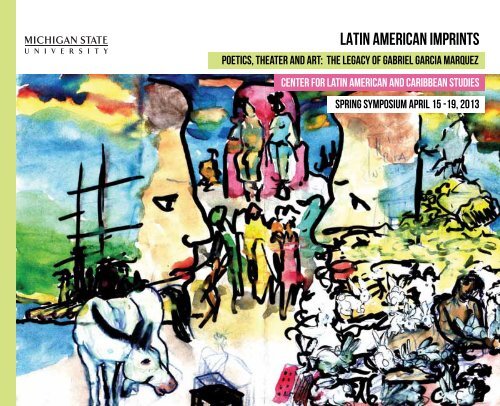

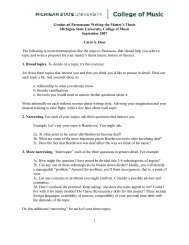
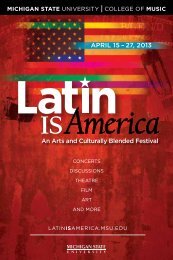
![evaluation form [PDF] - MSU College of Music - Michigan State ...](https://img.yumpu.com/48155330/1/190x245/evaluation-form-pdf-msu-college-of-music-michigan-state-.jpg?quality=85)
